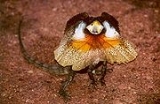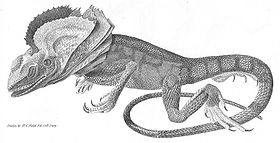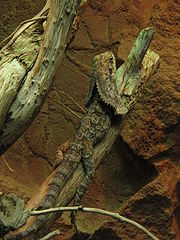
Frill-necked Lizard
Encyclopedia
The frill-necked lizard (Chlamydosaurus kingii), also known as the frilled lizard or frilled dragon, is found mainly in northern Australia
and southern New Guinea
. Its name comes from the large frill
around its neck, which usually stays folded against the lizard's body. It is largely arboreal, spending the majority of the time in the trees. The lizard's diet consists mainly of insects and small vertebrate
s. The frill-necked lizard is a relatively large lizard, reaching up to 91.4 cm in length. It may also be kept in captivity.
is supported by long spines of cartilage which are connected to the jaw bones. When the lizard is frightened, it gapes its mouth, exposing a bright pink or yellow lining; the frill flares out as well, displaying bright orange and red scales. This reaction is often used to discourage predators or during courtship. The lizard is a member of the agamid family. It a relatively large lizard, growing up to 91.4 cm. The lizard is also capable of bipedal locomotion.
The frill-necked lizard does not have a standard colour; however, it is characterised by a body that is darker than its frill. There is only one recorded species of the frill-necked lizard; however, the immense variations of colour among the species has led some scientists to hypothesise more than one species.
woodlands. The frill-necked lizard is an arboreal lizard, meaning it spends a majority of its time in the trees. The lizard ventures to the floor only in search of food, or to engage in territorial conflicts. The arboreal habitat may be a product of the lizard's diet, which consists mainly of small arthropods and vertebrates (usually smaller lizards). However, the trees are most importantly used for camouflage. There is not one standard colour: rather, colouration varies according to the lizard's environment. For example, a lizard found in a dryer, clay filled environment will most likely have a collage of oranges, reds, and browns; whereas a lizard found in a damper, more tropical region will tend to show darker browns and greys. This suggests that the lizards use their habitats for protection in the form of camouflage.
ic and maintains its homeostatic body temperature by basking for up to 40 minutes. This achieves an average of 2–3 degrees Celsius above the surrounding temperature. Weather conditions, including sunlight, are the main factors regulating the lizards’ temperature.This basking period usually occurs in the morning to early afternoon. During the basking period the lizard will be found near the bottom of a tree and out from under the forest canopy. This insures maximum exposure to sunlight. However, the lizard's final internal temperature depends mainly on the ambiance of the surrounding environment. It is thought that the lizard's frill aids in thermoregulation.
 The frill-necked lizard is sexually dimorphic; meaning the male and female frill-neck differ in their physical appearance. This dimorphism is apparent in the length of the lizard; the male is generally larger than the female. There is little to no dimorphism in the color of the lizard. Frill-necked lizards breed in the early wet season from September to October. Adult males fight for mates, displaying their frills and biting each other. One to two clutches of 8–23 eggs are laid from early to mid-wet season from November to February. The eggs are laid in a nest 5–20 cm below ground, and usually in sunny areas. Incubation takes two to three months. Gender is partly temperature determined
The frill-necked lizard is sexually dimorphic; meaning the male and female frill-neck differ in their physical appearance. This dimorphism is apparent in the length of the lizard; the male is generally larger than the female. There is little to no dimorphism in the color of the lizard. Frill-necked lizards breed in the early wet season from September to October. Adult males fight for mates, displaying their frills and biting each other. One to two clutches of 8–23 eggs are laid from early to mid-wet season from November to February. The eggs are laid in a nest 5–20 cm below ground, and usually in sunny areas. Incubation takes two to three months. Gender is partly temperature determined
, with extreme temperatures producing exclusively females, and intermediate temperatures (29 to 35°C) producing equal numbers of males and females. Their eggs are soft-shelled.
s, owls
, larger lizards, snakes, dingoes and quolls.
 A frill-necked lizard was featured on the reverse
A frill-necked lizard was featured on the reverse
of the Australian 2-cent coin
until 1991. A frill-necked lizard, known as "Lizzie," was the mascot
for the 2000 Paralympic Games
.
The emblem of the Australian Army's Regional Force Surveillance Unit, Norforce (North West Mobile Force) is the frill-necked lizard. The lizard was selected as the unit's emblem because of its speed, aggression, and ability to blend in with its surroundings.
Because of their unique appearance and behaviour, the frill-necked lizard is commonly depicted in children's cartoons. A frill-necked lizard named Frank appears in the Disney
film The Rescuers Down Under
and one named Osgood appears in the anime
Noozles
. In Adventures of the Little Koala
, the character "Macky Macky" is a frill-necked lizard whose neck frill raises up when he gets excited. It is also the fauna
symbol used for the Australian wildlife television program, Totally Wild
.
In the film Jurassic Park
, the dinosaur Dilophosaurus
was portrayed with a fictional neck frill, which was raised during attack, similar to that of a frill-necked lizard. The movie generated an increase in demand for the frill-necked lizard as a pet.
Australia
Australia , officially the Commonwealth of Australia, is a country in the Southern Hemisphere comprising the mainland of the Australian continent, the island of Tasmania, and numerous smaller islands in the Indian and Pacific Oceans. It is the world's sixth-largest country by total area...
and southern New Guinea
New Guinea
New Guinea is the world's second largest island, after Greenland, covering a land area of 786,000 km2. Located in the southwest Pacific Ocean, it lies geographically to the east of the Malay Archipelago, with which it is sometimes included as part of a greater Indo-Australian Archipelago...
. Its name comes from the large frill
Neck frill
Neck frill is the popular term for the relatively extensive margin seen on the back of the heads of reptiles with either a bony support such as those present on the skulls of dinosaurs of the suborder Marginocephalia or a cartilaginous one as in the Frill-necked Lizard...
around its neck, which usually stays folded against the lizard's body. It is largely arboreal, spending the majority of the time in the trees. The lizard's diet consists mainly of insects and small vertebrate
Vertebrate
Vertebrates are animals that are members of the subphylum Vertebrata . Vertebrates are the largest group of chordates, with currently about 58,000 species described. Vertebrates include the jawless fishes, bony fishes, sharks and rays, amphibians, reptiles, mammals, and birds...
s. The frill-necked lizard is a relatively large lizard, reaching up to 91.4 cm in length. It may also be kept in captivity.
Description
The frill-necked lizard gets it's name because of the large ruff of skin which usually lies folded back against its head and neck. The neck frillNeck frill
Neck frill is the popular term for the relatively extensive margin seen on the back of the heads of reptiles with either a bony support such as those present on the skulls of dinosaurs of the suborder Marginocephalia or a cartilaginous one as in the Frill-necked Lizard...
is supported by long spines of cartilage which are connected to the jaw bones. When the lizard is frightened, it gapes its mouth, exposing a bright pink or yellow lining; the frill flares out as well, displaying bright orange and red scales. This reaction is often used to discourage predators or during courtship. The lizard is a member of the agamid family. It a relatively large lizard, growing up to 91.4 cm. The lizard is also capable of bipedal locomotion.
The frill-necked lizard does not have a standard colour; however, it is characterised by a body that is darker than its frill. There is only one recorded species of the frill-necked lizard; however, the immense variations of colour among the species has led some scientists to hypothesise more than one species.
Habitat
The frill-necked lizard is found mainly in the northern regions of Australia and southern New Guinea. The lizard inhabits humid climates such as those in the tropical savannahSavannah
Savannah or savanna is a type of grassland.It can also mean:-People:* Savannah King, a Canadian freestyle swimmer* Savannah Outen, a singer who gained popularity on You Tube...
woodlands. The frill-necked lizard is an arboreal lizard, meaning it spends a majority of its time in the trees. The lizard ventures to the floor only in search of food, or to engage in territorial conflicts. The arboreal habitat may be a product of the lizard's diet, which consists mainly of small arthropods and vertebrates (usually smaller lizards). However, the trees are most importantly used for camouflage. There is not one standard colour: rather, colouration varies according to the lizard's environment. For example, a lizard found in a dryer, clay filled environment will most likely have a collage of oranges, reds, and browns; whereas a lizard found in a damper, more tropical region will tend to show darker browns and greys. This suggests that the lizards use their habitats for protection in the form of camouflage.
Diet
Like many lizards, frill-necked lizards are insectivorous, feeding on cicadas, beetles, and termites. They especially favour butterflies and moths, their larvae even more so. Though insects are their primary source of food, they also consume spiders, other lizards, and small mammals. Like most members of the agamids (dragons), frill-necked lizards employ an ambush method of hunting, lying in wait for their prey. When the lizards eat, they eat in abundance; these binge periods usually occur during the wet season, when the lizards will ingest hundreds to thousands of alates (ants or termites).Thermoregulation
The frill-necked lizard is ectothermEctotherm
An ectotherm, from the Greek εκτός "outside" and θερμός "hot", refers to organisms that control body temperature through external means. As a result, organisms are dependent on environmental heat sources and have relatively low metabolic rates. For example, many reptiles regulate their body...
ic and maintains its homeostatic body temperature by basking for up to 40 minutes. This achieves an average of 2–3 degrees Celsius above the surrounding temperature. Weather conditions, including sunlight, are the main factors regulating the lizards’ temperature.This basking period usually occurs in the morning to early afternoon. During the basking period the lizard will be found near the bottom of a tree and out from under the forest canopy. This insures maximum exposure to sunlight. However, the lizard's final internal temperature depends mainly on the ambiance of the surrounding environment. It is thought that the lizard's frill aids in thermoregulation.
Reproduction and sexual dimorphism

Temperature-dependent sex determination
Temperature-dependent sex determination is type of environmental sex determination in which the temperatures experienced during embryonic development determine the sex of the offspring. It is most prevalent and common among amniote vertebrates that are classified under the reptile class, but is...
, with extreme temperatures producing exclusively females, and intermediate temperatures (29 to 35°C) producing equal numbers of males and females. Their eggs are soft-shelled.
Predatory threats
The species' main threats are eagleEagle
Eagles are members of the bird family Accipitridae, and belong to several genera which are not necessarily closely related to each other. Most of the more than 60 species occur in Eurasia and Africa. Outside this area, just two species can be found in the United States and Canada, nine more in...
s, owls
OWLS
OWLS is a mnemonic used by general aviation airplane pilots to assess an unprepared surface for a precautionary landing.Like all mnemonics this check has become part of aviation culture and folklore.OWLS:* Obstacles* Wind direction...
, larger lizards, snakes, dingoes and quolls.
In culture

Obverse and reverse
Obverse and its opposite, reverse, refer to the two flat faces of coins and some other two-sided objects, including paper money, flags , seals, medals, drawings, old master prints and other works of art, and printed fabrics. In this usage, obverse means the front face of the object and reverse...
of the Australian 2-cent coin
Australian 2 cent coin
The Australian two-cent coin was introduced in 1966 and was the coin of the second-lowest denomination until it was withdrawn from circulation in 1992 . It is still counted as legal tender....
until 1991. A frill-necked lizard, known as "Lizzie," was the mascot
Mascot
The term mascot – defined as a term for any person, animal, or object thought to bring luck – colloquially includes anything used to represent a group with a common public identity, such as a school, professional sports team, society, military unit, or brand name...
for the 2000 Paralympic Games
2000 Summer Paralympics
The 2000 Paralympic Games were held in Sydney, Australia, from 18 October to 29 October. The eleventh Summer Paralympic Games, an estimated 3800 athletes took part in the Sydney programme. They commenced with the opening ceremony on 18 October 2000...
.
The emblem of the Australian Army's Regional Force Surveillance Unit, Norforce (North West Mobile Force) is the frill-necked lizard. The lizard was selected as the unit's emblem because of its speed, aggression, and ability to blend in with its surroundings.
Because of their unique appearance and behaviour, the frill-necked lizard is commonly depicted in children's cartoons. A frill-necked lizard named Frank appears in the Disney
The Walt Disney Company
The Walt Disney Company is the largest media conglomerate in the world in terms of revenue. Founded on October 16, 1923, by Walt and Roy Disney as the Disney Brothers Cartoon Studio, Walt Disney Productions established itself as a leader in the American animation industry before diversifying into...
film The Rescuers Down Under
The Rescuers Down Under
The Rescuers Down Under is a 1990 American animated film produced by Walt Disney Feature Animation and released by Walt Disney Pictures and Buena Vista Distribution on November 16, 1990...
and one named Osgood appears in the anime
Anime
is the Japanese abbreviated pronunciation of "animation". The definition sometimes changes depending on the context. In English-speaking countries, the term most commonly refers to Japanese animated cartoons....
Noozles
Noozles
, also known as The Wonderous Koala Blinky, is a 26-episode anime by Nippon Animation Company that was originally released in Japan in 1984, under the title Fushigi na Koara Burinkī or Brinky and Printy. It depicts the adventures of a 12-year old girl named Sandy and her koala friends, Blinky and...
. In Adventures of the Little Koala
Adventures of the Little Koala
is an anime TV series produced by Tohokushinsha Film Corporation. It aired originally in Japan on TV Tokyo from October 4, 1984 through March 28, 1985, and then aired in the United States on Nickelodeon dubbed in English from 1987 to 1994...
, the character "Macky Macky" is a frill-necked lizard whose neck frill raises up when he gets excited. It is also the fauna
Fauna
Fauna or faunæ is all of the animal life of any particular region or time. The corresponding term for plants is flora.Zoologists and paleontologists use fauna to refer to a typical collection of animals found in a specific time or place, e.g. the "Sonoran Desert fauna" or the "Burgess shale fauna"...
symbol used for the Australian wildlife television program, Totally Wild
Totally Wild
Totally Wild is an Australian children's television series. It has been in production since 1992, airing on Network Ten since day one. It has the format of a news program, and does stories on topics such as Australia's native flora and fauna, action sports, the environment, science, and technology...
.
In the film Jurassic Park
Jurassic Park (film)
Jurassic Park is a 1993 American science fiction adventure film directed by Steven Spielberg. The film is based on the novel of the same name by Michael Crichton. It stars Sam Neill, Laura Dern, Jeff Goldblum, Richard Attenborough, Martin Ferrero, and Bob Peck...
, the dinosaur Dilophosaurus
Dilophosaurus
Dilophosaurus was a theropod dinosaur from the Sinemurian stage of the Early Jurassic Period, about 193 million years ago. The first specimens were described in 1954, but it was not until over a decade later that the genus received its current name...
was portrayed with a fictional neck frill, which was raised during attack, similar to that of a frill-necked lizard. The movie generated an increase in demand for the frill-necked lizard as a pet.
External links
- Australia Advances - Frilled Neck Lizard by CSIROCommonwealth Scientific and Industrial Research OrganisationThe Commonwealth Scientific and Industrial Research Organisation is the national government body for scientific research in Australia...
- Frilled-neck lizard babies are out! by ABC ScienceAustralian Broadcasting CorporationThe Australian Broadcasting Corporation, commonly referred to as "the ABC" , is Australia's national public broadcaster...
- Frilled Lizard (Chlamydosaurus kingii) by Zoo and Aquarium Association

